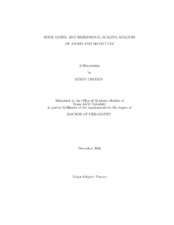| dc.description.abstract | It is generally believed that the old quantum theory, as presented by Niels Bohr
in 1913, fails when applied to many-electron systems, such as molecules, and nonhydrogenic
atoms. It is the central theme of this dissertation to display with examples
and applications the implementation of a simple and successful extension of Bohr’s
planetary model of the hydrogenic atom, which has recently been developed by an
atomic and molecular theory group from Texas A&M University. This â€Âextendedâ€Â
Bohr model, which can be derived from quantum mechanics using the well-known
dimentional scaling technique is used to yield potential energy curves of H2 and several
more complicated molecules, such as LiH, Li2, BeH, He2 and H3, with accuracies
strikingly comparable to those obtained from the more lengthy and rigorous â€Âab initioâ€Â
computations, and the added advantage that it provides a rather insightful and
pictorial description of how electrons behave to form chemical bonds, a theme not
central to â€Âab initio†quantum chemistry. Further investigation directed to CH, and
the four-atom system H4 (with both linear and square configurations ), via the interpolated
Bohr model, and the constrained Bohr model (with an effective potential),
respectively, is reported. The extended model is also used to calculate correlation
energies.
The model is readily applicable to the study of molecular species in the presence
of strong magnetic fields, as is the case in the vicinities of white dwarfs and neutron
stars. We find that magnetic field increases the binding energy and decreases the bond length.
Finally, an elaborative review of doubly coupled quantum dots for a derivation of
the electron exchange energy, a straightforward application of Heitler-London method
of quantum molecular chemistry, concludes the dissertation.
The highlights of the research are (1) a bridging together of the pre- and post
quantum mechanical descriptions of the chemical bond (Bohr-Sommerfeld vs Heisenberg-
Schr¨odinger), and (2) the reporting of the appearance of new bound states of H2 in
the presence of very strong magnetic fields. The new states emerge above the critical
value of 5 × 107 G, and hence cannot be obtained perturbatively. | en |


